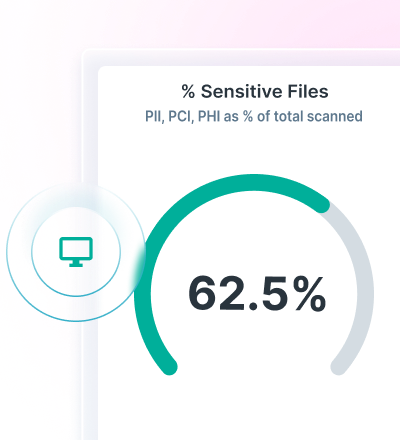DSPM vs CSPM vs SSPM Comparison: Picking the Right One
0 min read

Tim Herr
Cloud security has evolved from locking down infrastructure to understanding how data moves across every app and service. Misconfigurations, excessive permissions and shadow data remain top causes of breaches, especially in multicloud and SaaS environments. That’s why posture management has become essential.
This guide offers a clear comparison of Cloud Security Posture Management (CSPM), SaaS Security Posture Management (SSPM) and Data Security Posture Management (DSPM) to show how they work together to protect your data from cloud to endpoint.
Why Cloud and SaaS Posture Management Matters
The average organization now runs data across dozens of SaaS platforms and multiple cloud providers. While this flexibility accelerates business, it also multiplies risk. Misconfigurations, over-permissioned accounts and ungoverned data access have become leading causes of breaches.
To stay ahead, security teams rely on posture management solutions that continuously assess, monitor and remediate risk. Three approaches dominate the field: CSPM, SSPM and DSPM. Understanding how these approaches differ is key, and a side-by-side comparison helps clarify where each delivers value.
Each covers a critical layer of the cloud stack. Together, they build a complete picture of risk across infrastructure, applications and data.
What Is Cloud Security Posture Management (CSPM)?
CSPM solutions safeguard cloud infrastructure—public, private and hybrid—by continuously analyzing configurations for vulnerabilities or policy drift. They were developed to prevent the most common cloud threats: misconfigured storage buckets, overly broad IAM policies and unencrypted services.
A strong CSPM platform typically:
- Scans resources across AWS, Azure and Google Cloud for misconfigurations
- Benchmarks against security frameworks like CIS, NIST or ISO
- Detects public exposure of sensitive workloads or data stores
- Automates remediation through native cloud APIs
CSPM gives you visibility and compliance at the infrastructure level. It ensures that every cloud service is deployed securely and aligns with your organization’s security baselines.
But CSPM focuses on the environment and not on what’s inside it. That’s where SSPM and DSPM extend its reach.
What Is SaaS Security Posture Management (SSPM)?
While CSPM governs infrastructure, SSPM governs SaaS applications. With more sensitive data flowing through tools like Microsoft 365, Slack, Salesforce and OneDrive or Box, SSPM provides continuous monitoring for configuration and permission risk.
An effective SSPM solution will:
- Monitor connected SaaS apps for insecure settings or risky third-party integrations
- Identify excessive permissions, inactive accounts and shadow users
- Alert on compliance drift or data exposure caused by sharing links
- Offer remediation guidance to align configurations with best practices
SSPM provides the same kind of guardrails for SaaS as CSPM does for cloud infrastructure. It focuses on how users, identities and integrations impact risk across the SaaS ecosystem.
Together, CSPM and SSPM create a strong foundation, but neither directly addresses data risk. That’s where DSPM completes the picture.
What Is Data Security Posture Management (DSPM)?
DSPM locates and identifies sensitive data. DSPM answers the question that CSPM and SSPM cannot: What sensitive data do I have, where is it and who can access it?
Instead of focusing on configurations, DSPM focuses on the data itself—wherever it resides across structured and unstructured systems. It discovers, classifies and monitors sensitive data in real time to uncover risk that stems from exposure, misuse or lack of governance.
A robust DSPM solution should:
- Discover and classify data across cloud, on-premises and SaaS sources
- Label data automatically using AI-driven context and sensitivity analysis
- Map data access and sharing patterns to understand exposure
- Quantify data risk so teams can prioritize remediation
- Feature strong integrations to enforce controls and monitor usage continuously
Forcepoint DSPM stands out by combining visibility with enforcement through Forcepoint Data Detection and Response (DDR )and Forcepoint Data Loss Prevention (DLP). It extends posture management into active protection—linking insights to automated controls.
The following comparison table highlights how CSPM, SSPM and DSPM differ in focus, risk coverage and outcomes.
DSPM vs CSPM vs SSPM: Key Differences
Capability | CSPM | SSPM | DSPM |
|---|---|---|---|
Primary Focus | Cloud infrastructure | SaaS applications | Sensitive data |
Risk Addressed | Misconfigurations, compliance drift | Over-permissioned users, risky app integrations | Data exposure, ungoverned access |
Where It Operates | AWS, Azure, GCP | M365, Salesforce, Slack, Box | Across cloud, SaaS, and on-prem data |
Example Threat Prevented | Publicly exposed S3 bucket | Overshared Google Drive folder | PII stored in an unprotected database |
Key Outcome | Secure and compliant cloud resources | Properly configured SaaS apps | Protected and governed data everywhere |
While CSPM and SSPM enhance the security posture of your systems and apps, DSPM provides the “data truth” that ties everything together. Without DSPM, you can have a secure cloud but still expose critical information through unmanaged access or forgotten repositories.
How CSPM, SSPM and DSPM Work Together
CSPM, SSPM and DSPM don't compete with one another. They are complementary parts of a unified posture management framework. A comparison of their roles makes it clear that each operates at a different layer of the security stack.
- CSPM scans for cloud misconfigurations before they become vulnerabilities.
- SSPM ensures SaaS applications are securely configured and integrated.
- DSPM discovers and governs sensitive data across all of it, giving you full visibility from infrastructure to application to content.
Forcepoint unifies these capabilities through the Forcepoint Data Security Cloud. This integrated platform brings together DSPM, DDR, DLP and CASB to protect data everywhere it moves—across clouds, apps, endpoints and users.
Why DSPM Completes the Posture Puzzle
CSPM and SSPM deliver important insights, but neither tells you whether the data at risk is confidential, regulated, redundant, obsolete or trivial. DSPM provides that missing intelligence.
By discovering and classifying data contextually, DSPM enables security teams to focus remediation where it matters most. It bridges visibility and control by answering:
- Where is sensitive data located?
- Who has access, and should they?
- Is it shared externally or through AI assistants like Copilot?
When integrated with enforcement layers like Forcepoint DLP and Risk Adaptive Protection (RAP), DSPM turns posture management into proactive data protection.
Forcepoint DSPM: Visibility That Drives Action
Forcepoint DSPM delivers continuous discovery and classification of both structured and unstructured data. Its AI Mesh technology enables consistent sensitivity labeling across distributed environments, including hybrid and multicloud systems.
The result is a single source of truth for data posture—enriched with risk context and tightly integrated with real-time protection tools. Combined with DLP and CASB, Forcepoint’s DSPM transforms posture insights into automated response, preventing breaches before they occur.
For organizations managing large SaaS and cloud footprints, this unified approach reduces complexity, minimizes blind spots and accelerates compliance with frameworks like GDPR, CCPA and HIPAA.
FAQ: DSPM vs CSPM vs SSPM
1. Is DSPM a replacement for CSPM or SSPM?
No. DSPM complements CSPM and SSPM by adding data-level visibility and control. CSPM and SSPM identify configuration and identity risks; DSPM reveals where sensitive data resides and whether it’s protected.
2. Do I need all three?
Yes, especially if you operate in a multicloud or SaaS-heavy environment. Each tool addresses a different layer of the security stack. Together, they form a holistic approach to cloud and data security posture management.
3. How does DSPM integrate with DLP?
DSPM identifies and classifies sensitive data. DLP enforces protection policies based on that intelligence. With Forcepoint, DSPM, DDR and DLP work in tandem to monitor, prevent and respond to data risk continuously.
4. What role does SSPM play in AI adoption?
SSPM helps govern SaaS integrations with generative AI tools like Microsoft Copilot by ensuring that APIs and permissions don’t expose sensitive data to unintended models or users.
5. Where can I find a DSPM vs CSPM vs SSPM comparison?
You can use the comparison table above for a quick overview of how each solution addresses a different layer: cloud, SaaS and data. Together, they form a complete posture management strategy.
Takeaway
CSPM secures the cloud. SSPM secures SaaS applications. DSPM secures the data itself.
To build a resilient posture, organizations need all three working in unison. Forcepoint makes that possible by unifying DSPM, DDR, DLP and CASB within a unfied platform.
Explore how Forcepoint DSPM unifies insights from CSPM and SSPM into a single platform for smarter, faster posture management and see why it stands apart in any DSPM vs CSPM comparison.

Tim Herr
Read more articles by Tim HerrTim serves as Brand Marketing Copywriter, executing the company's content strategy across a variety of formats and helping to communicate the benefits of Forcepoint solutions in clear, accessible language.
 Gartner®: Market Guide for Data Security Posture ManagementView the Report
Gartner®: Market Guide for Data Security Posture ManagementView the Report
X-Labs
Get insight, analysis & news straight to your inbox

To the Point
Cybersecurity
A Podcast covering latest trends and topics in the world of cybersecurity
Listen Now









